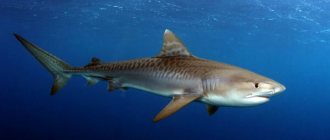When we hear the word “predator”, we think of large, fast, strong and menacing animals, which, of course, we would not want to pet or even see up close. However, the hunting instinct and fearsome appearance are characteristics that these animals acquire only in adulthood. And when they're still babies, these little furballs are actually quite adorable!
I made a small selection of photographs of terrifying wild animals whose babies look the cutest. Enjoy watching!
Polar bear
Female polar bears are the world's largest land predators. Even before the birth of her offspring, the mother bear digs a deep hole in the snow and remains there with the cubs for the first few months of their lives. Only after the cubs are strong enough (about three or four months) does the mother take them hunting in the sea and eat food for the first time in this long period. The cubs will stay with her for another two years while they learn to catch fish, seals and other animals.
Capricorn and 3 other zodiac signs whose glass is always half empty
“Rasputin” on bass guitar: the Italian’s video in Russia collected 8 million views
Many lines and two branches: we read the marriage lines under the little finger
Where do they live?
The smallest predator lives throughout the Northern Hemisphere. It is present in North America, Europe, Asia and the northern parts of Africa. It was also artificially introduced to control rodents in New Zealand, Crete, Malta and the Azores.
Almost any habitat is suitable for the weasel - meadows, forests, tundra, dense tropical thickets. She feels great both above and below the ground. Easily maneuvers among fallen leaves, through rodent burrows and in thick snow.
The world's smallest Predator is Weasel. foto: https://pixgood.com/snow-weasel.html
The smallest predator does not waste its time digging holes, but occupies ready-made shelters for rodents. They do not live in one place all the time, so in the habitat of one weasel there are usually several lairs at once.
For them, in principle, the surrounding plants are not important. The main factor in the survival of this animal is the presence of a large number of potential victims.
Lynx
Although wild cats are particularly fast predators, like many others, they are born blind and helpless. They spend the first few months of their lives next to their mother, learning to hunt and catch prey. After nine months of nurturing, the mother cat leaves them, often suddenly, because now it is their time to fend for themselves. In some cases, young lynxes continue to live together for a while, but eventually they will go their separate ways.
The smallest bird of prey
The smallest predator among birds is the tiny falcon. The dimensions of this bird are amazing: 15 cm including the tail, weight - 35 g. The tiny falcon looks exactly the same as the large species of this bird, being its smaller copy.
The baby falcon lives mainly in America. The best habitat for this bird is wooded areas. They can also be found in Thailand, Malaysia, Indonesia and Singapore.
The baby falcon has amazing hunting skills: endurance, courage and playfulness. However, birds hunt only for insects or tiny reptiles. Considering the smallness of the predator, it is quite difficult for this representative of birds to hunt larger prey.
Panther
The black panther is most often found in forested areas of Asia, where the color of its fur aids in camouflage. An adult black panther is a dangerous predator that has cunning tactics in hunting. They hide until the prey comes close enough to attack. But as children, these cubs are very friendly and love to play with each other. Kittens spend the first few months of their lives with their mother, but later they leave her and fend for themselves.
Aquarius - listen to intuition: forecast for all signs for the spring equinox
Serebryakov returned to Russia. Shukshina believes that he should not have left
Peach coloring: 10 ideas for creating an incredibly delicate look
The predatory animal is in second place in terms of miniature size
After caresses, in descending order of miniature, the forest ferret can be placed in second place. It also belongs to the weasel family. The length of its body does not exceed 48 centimeters, the average and more common size of a ferret is 40 centimeters. Small predators do not grow more than 45 centimeters in height.
The forest ferret also feeds on rodents, for example, mice and voles. Snakes, large insects and toads can also snack on the animal.
This no longer the smallest predator is very brave and is capable of attacking animals larger than itself. Quick reaction, agility and high running speed allow the animal to deftly avoid danger.
A significant difference between ferrets and weasels is their sedentary lifestyle. As a rule, they do not move between different territories and are tied to one place of residence. Ferrets prefer to live in naturally created shelters. For example, among a pile of branches, stones and in haystacks. But they also do not dig their own dens and like to move into pre-prepared ones.
Falcon
Let's pay a little attention to birds - no less formidable predators. The falcon feeds exclusively on live prey, which it catches with its feet. The cubs that have just hatched from the eggs have white fluffy plumage. This fluff turns into full-fledged feathers within three to five weeks. Chicks are very vulnerable at the beginning of their lives, which leads to high mortality rates. And birds that have reached maturity live on average about 15 years.
Keeping pets at home
Residents of Ancient Rome and early medieval Europe used weasels as a pet to hunt mice. But when the Old World was populated by large gray rats, which are difficult for small animals to cope with, weasels were replaced by ferrets and cats.
Feeding weasels with milk from a syringe. Photo by: Armando Caldas.
If you decide to get a pet, please note that babies are easier to tame, they will require careful care and you will have to tinker with feeding them. Therefore, in practice, adult animals are more often caught and gradually tamed. But in the process of taming, your hands will be bitten more than once. If you are willing to spend a lot of time adapting with the animal, then it will become a loyal and reliable friend.
Raising weasels at home from a very early age. Photo by: Armando Caldas.
You will have to feed your pet fresh and high-quality meat and eggs. The animal must always have clean water.
The weasel will choose its own place to rest. She can take the place of another pet. In addition, she easily takes food from cats and dogs.
Common weasel (Mustela nivalis). Photo credit: Gary Mann.
Your weasel can cause a lot of problems if your neighbors have poultry. She will destroy all these birds, turning your neighbor into a fierce enemy. But if the bird lives with you, the weasel will not touch it, since it does not hunt where it lives.
Python
Snakes of this species are among the longest in the world. These predators usually feed on birds and small mammals, but they can also swallow larger animals such as crocodiles and even deer. After waking up from hibernation, hungry pythons can even attack people. While most snakes tend to leave their eggs behind, pythons prefer to wrap them around their own body to keep their young warm. During their lifetime, tiny snakes reach sizes of up to 6 meters!
Apple does not leave the market in Russia, agreeing to install Russian software
They wanted to clear the roof of snow and almost ended up under it: video
Haircuts were not Aunt Tanya’s thing: Menshova remembered her first “stylist”
Sundew
There are predators not only among animals, but also among plants. The brightest and most common plant hunter is the sundew. It grows on almost any type of soil, on mountain slopes, swamps, and tropical forests. The distribution area is everywhere except Antarctica.
All representatives of this genus feed on insects. The surface of their leaves is covered with small hairs, and they, in turn, are covered with sticky nectar that attracts flies and midges. When an insect falls into a trap, the leaf around it closes and absorbs all the nutrients from the prey.
So that insects can pollinate the flower, it is placed on a long stem in sundews. Then the fly will not fall into the trap.
Today it has become very popular to have sundews as a houseplant. On forums, happy owners even share secrets on how to successfully catch flies to feed their pet.
Giant otter
The giant otter is the largest individual in the otter family, reaching a length of about 1.8 meters. This otter feeds on prey caught in shallow waters, such as medium-sized fish, crabs and even anacondas. Otter pups, which in adulthood are characterized by very aggressive behavior towards anyone who tries to harm members of their family, are born in burrows dug by the females underground, completely blind.
The whole family participates in raising offspring. The father of the offspring, sisters and brothers will come to the aid of the young otter. They will help you learn hunting and swimming. Their families are very close-knit, especially if the young cubs are in danger.
List of the most famous predatory fish with photos
The range of freshwater predators includes chub, pike perch, grayling, Arctic omul, asp, pike, catfish, burbot, perch, eel, and sterlet. The sea kingdom is home to most of the villains. The most famous species: sharks, moray eels, barracudas, swordfish, monkfish, tuna, bluefish bonito, rock bass, sea ruffe, cod, catfish, beluga, flounder.
Freshwater
Many of them, despite their predatory nature, are valuable commercial resources. Being an important link in the ecological system of reservoirs, they eat weak and sick fish. They regulate the number of excessively multiplied freshwater fish, the same predators or herbivores.
Their brutal appetite helps them fulfill the important role of orderlies. Each species is famous for its habits and characteristics.
The common catfish is the king of rivers and lakes. The largest representative among freshwater. Lives up to 50 years and can reach 5 meters in length. Even in the last century, catfish weighing more than 200 kg were caught. There are many legends about giant catfish that drag away fishermen. Dnepropetrovsk ichthyologist Oleg Makarenkov debunks myths: “A catfish is not able to swallow a person, since his mouth is large and his throat is small. But if it is necessary to protect the offspring, or in self-defense, it can strike with its tail.” Catching a 100 kilogram catfish is very rare.
The elongated carcass of a pike perch is completely covered with large gray or green scales. The pointed head is slightly flattened on top. A sharp green fin rises high on the back. The abdomen is white. Fish can reach a weight of 20 kg and a meter in length.
All predatory piranhas are concentrated in fresh water bodies of the southern tropics. The length of their body does not exceed 50 cm. The body is characteristically flattened laterally, silver-gray or black in color. Sometimes with yellow, scarlet or orange splashes. Frightening sharp triangular teeth peek out from the mouth. The piranha's bite is destructive. An adult easily crushes sticks.
Today, science knows about 10 species of pike. They are characterized by a very diverse appearance, character and size. They perform the role of water orderlies. Weakened fish are the first to fall into their mouths. They grow up to 2 meters and weigh 40 kg.
In the perch family, which numbers more than 100 species, the most common is the river one. All perches can be identified by transverse lines on their sides. If the number of perch in a reservoir prevails over other species, adult fish eat their young.
The tributaries of the Amazon are home to the arapaima, a well-known tropical predator. The unique creature is the same age as dinosaurs. Even in its appearance there is a resemblance to reptiles. Its color is also unusual. Bright red spots appear on the silvery scales closer to the tail and along the belly. Among the South American Indians it is known by another name - pirarucu, which means red fish. Refers to giants. It can reach three meters in length and two centners in weight. The structure of the body and fused fins is similar to a fattened eel. The elongated, slightly flattened head is covered with a bone plate. Large, elastic scales are tightly planted. Reminds me of armor. Which makes it inaccessible to piranhas. With its terrifyingly wide mouth, the arapaima swallows bottom-dwelling fish. If it floats to the surface, then birds flying over the water also risk ending up in its mouth.
The burbot's habitat is cool and clean water. His element is northern rivers. Any young fish, minnows and ruffes will become prey for the freshwater predator. Huddled in the silt, or hiding under a snag, it hunts, luring the prey with the help of a whisker moving like a worm. It can reach a meter in length and weigh about 30 kilograms.
An amazing fish, the only representative of its species - the silver bream. Leads a gregarious lifestyle. Moreover, the school can be so thick that it is difficult for fishermen to push their oar through. Known by other names: flathead, lupirka, laskirka, gustira. Although a predator, it is not very active and not aggressive. She will not swim tirelessly after prey. Prefers mollusks, worms and crustaceans. Likes to rest on the bottom, among snags. Slowly growing. A one-year-old fish is only about 5 cm. Over a long life, up to 15 years, it can gain a little more than a kilogram in weight and 40 cm in length.
The ruffe is the smallest predatory representative of freshwater fish. Does not grow more than 15 cm. Maximum weight 90-100 grams. Without a twinge of conscience, it eats fish eggs and fry. Due to the absence of a swim bladder, it can lie in ambush for a long time and patiently wait for prey.
Where, however, he himself can become prey for burbot. You can meet the unpretentious ruff anywhere:
- in reservoirs;
- canals and ponds;
- in large and small rivers;
- in fresh sea bays;
- in the lakes.
Representatives of salt water bodies
Many predators live in the salty waters of the oceans and seas.
Sharks are numerous and varied. Some species do not exceed two tens of centimeters, others reach two tens of meters. So whale shark. Swims on the surface of the ocean with its mouth wide open, but eats only plankton and small fish. Despite its belonging to a predatory fish species and the abundance of small teeth (about 15 thousand), it does not at all look like an avid hunter. You wouldn't call her a glutton. She eats only 100-200 kg per day. This is about 1% of its gigantic size. The harmless largest living giant.
A lover of ambush attacks, the moray eel's closest relative is the eel. It is also densely covered with mucus and lacks scales. It’s true that it’s less aggressive, and the coloring is calmer and more monochromatic. Camouflage color helps during hunting.
Among the unusual representatives of salt water bodies, one can distinguish the common toadfish. Only a 40 centimeter body weighs about one and a half kilograms. The large, wide head is flattened at the top. The protruding lower jaw, bulging eyes and wrinkled skin with growths and spines do not add to the presentability. Buries itself in the sand and patiently waits for a gaping victim. But her main feature is the ability to grumble and even sing. Attracts with its unusualness.
Passing
Unique representatives of spawning fish include migratory fish. Some fish that grow and live in the sea come to rivers to spawn. These are the most valuable commercial fish, representatives of sturgeon and salmon. Others, on the contrary, migrate from rivers to seas. Among them, the river eel is famous. Goes on a journey to the ocean in order to continue the family line. Gobies from the sea shores are sent to the rivers flowing into them.
River
In India, Bangladesh and Nepal you can find the Goonch catfish, which is fearsome in size and has a reputation as a cannibal. There is a possibility that people became the unwitting culprits in turning catfish into monsters by feeding them human remains after funeral rites. Its dimensions reach 2-3 meters, and its average weight is 140 kilograms.
Of the 180 known species, the electric eel is the most dangerous. A mysterious inhabitant of shallow muddy rivers of the South American continent. It can reach three meters in length and weighs 40 kg. The power of the electric pulse is 350 V. Not lethal to humans, but enough to stun. You may lose consciousness. If there is prey nearby, it shakes its body to create a charge, instantly killing the prey.
Throughout Africa and in South American rivers, the tiger goliath fish is found. The river monster inspires fear and horror. The giant piranha is capable of attacking crocodiles. Like a tiger, it tears its prey with sharp fangs. The predator grows up to a meter and weighs 50 kg. Meeting her is dangerous for a person.
The homeland of the snakehead is Central and South Asia. The freshwater predator is striking in its vitality. It can withstand up to 5 days without water, burrowing into the mud at the bottom. It is able to crawl from body of water to body of water on land. An ancient Chinese proverb says: “When they see the Zhuan fish, which looks like a frog covered with bristles, there will be a great drought.” The Amur or brown snakehead lives in our country. An adult fish 1 meter long weighs 10 kg. Tender white meat will be an important factor for gourmets. It hunts all living things in the water, eats frogs and insect larvae. The voracious fish holds its prey with its sharp teeth.
Ozernye
The lakes are also inhabited by predators.
These include trout. The main habitat is Lake Onega and Lake Ladoga. The schooling fish with a slightly elongated flattened body reaches a meter in length. Coloration varies somewhat depending on the age and habitat of the fish. There are dark spots, and an orange stripe near the mouth. The size also ranges from 25 cm to a meter in large lakes. The weight of large fish is 8-12 kg.
Whitefish prefers the cool waters of Siberian and Karelian lakes. An elongated, slightly compressed carcass with large scales. The head is small. Small fish. An adult weighs one and a half kilograms.
The Baikal omul is sensitive to oxygen and is covered with small silvery scales. Settles at junctions with large rivers. Leads a gregarious lifestyle. An adult fish weighs 700-800 grams.
Aquarium
Popular species of aquarium predators attract with their exotic appearance and capricious character. Many people know astronotus, cichlids, or piranhas. It's interesting to watch their habits. Extravagant fish need increased attention and adherence to certain rules. With proper care, they can become cute pets and begin to react and recognize their owner.
Description of the most popular aquarium predators. List and photos:
- the body of the green tetradon is decorated with black spots. Large eyes stand out. A characteristic feature is the absence of scales. Strong jaws and plates in place of teeth for grinding prey. Extremely aggressive fish. Maximum size 15-17 cm;
- Cichlids are the most popular carnivores. Colorful and obstinate. They are good parents. Their behavior is interesting to watch. Grows up to 35 cm;
- red parrot is a child of human hands. Attractive with its bright orange color. A negative factor will be the impossibility of breeding them due to the infertility of males. Not found in nature. Grows up to 20 cm;
- Piranhas are the most desirable aquarium predators. The length of an adult fish is 30 cm. An experienced aquarist is required to breed them. There are situations when a fish injures its owner;
- An interesting representative of the Astronotus family is a selective albino. Power, beauty, intelligence. The head of the underwater inhabitant is large with expressive eyes. A 30 centimeter fish grows into a temperamental bull of 25-35 cm. Expensive look
- The predatory catfish Clarius is omnivorous. A different type of fish will end up on his dinner table. Reach half a meter in length.
Brown bear
Brown bear cubs are born during hibernation. Once the cubs go outside and begin to explore their environment, they remain close to their mother for another two years. The she-bear teaches them to hunt. During this time, the young bears are still vulnerable, and the mother bear's job is to be vigilant and repel attacks from attacking animals.
“Fisherman’s” sandals and 4 more pairs of shoes without heels, in which your feet will not get tired
“Start by finding yourself”: Tina Kandelaki gave advice to single women
An attractive image is easy to maintain even after 50 years: 10 fashionable men's haircuts
What is the behavior and lifestyle of weasels?
Weasels prefer to live alone. They spend most of their time foraging for food. Moreover, their activity in no way depends on the time of day. To better navigate the terrain, the smallest predator often stands on its hind legs, takes a “column” pose, showing off its white belly. Thus, he scans the area for the presence of predators or prey.
Each animal has its own territory, which it jealously protects. The only exception is the breeding season. At this time, the male leaves his possessions and goes in search of the female. And although animals do not live in packs, there is a hierarchy among them. The older male dominates females and juvenile males. To demonstrate its superiority, the smallest predator makes frightening sounds, shows its grin and sometimes even performs a “war dance”.
Tiny animals must eat regularly to survive. They need especially a lot of food during the cold season. It is interesting that although a weasel is capable of killing an animal twice its size, it can eat no more than a few grams of meat in one meal. Therefore, the predator learned to preserve food by disguising it in shelters and treating the entrance with secretions from the sebaceous glands.
American alligator
The largest alligator in the entire family, its length reaches about four meters and its weight is 270 kilograms. They are born only 20 cm long and weighing 20 grams. Crocodiles grow for about 1-2 years. During this time, the alligator must learn to hunt birds, turtles, crabs, frogs, and so on. Next, the alligator leaves its family and sets out on its own.
The smallest insect predator
Do you know what the smallest insect predator is? This is an ant. Among the many species of this insect, truly dangerous and predatory ones are often found.
One of these species is myrmica ants. Their dimensions do not exceed 5 mm. Myrmic ants hunt invertebrates. Thanks to their poisonous sting, they immobilize the victim and have the opportunity to drag it to their lair and devour it as a group.
They are distributed throughout the Eurasian continent and can survive various weather conditions - both extreme heat and severe frost.
a lion
This wouldn't be a complete list of predatory animals if I didn't include lions. Like other cubs, young kings of the jungle need help from their parents. Unlike most other families, male lions also take part in feeding and protecting their young. Even after the cubs become stronger, the fathers continue to play with them and train them to improve their hunting skills.
Found a violation? Report content
Manul
Otocolobus manul comes from Greek words that can be translated as “dwarf ear.” cat is also called Pallas's cat , after the man who first described it in 1776. It was a naturalist from Germany P.S. Pallas.
In size, it resembles an ordinary cat: length - from 52 to 65 cm, and tail - from 23 to 31 cm. Pallas's cat weighs two to five kg. He has a thick and long tail, sideburns on his cheeks, and small and round ears.
Among the cats, the Pallas's cat is the fluffiest. The fur is gray, the fibers have white tips, which makes it seem like it is dusted with snow. There are narrow stripes. It can be seen in Asia, in steppe or semi-desert areas of the mountains.
It is active at night or early in the morning; during the day it sleeps in a shelter: in rocks or in old burrows. Eats rodents and pikas, sometimes larger prey. Pallas cats do not know how to run fast; they hide from enemies by climbing rocks and stones. Their numbers are rapidly declining.
Long-tailed cat
a long-tailed cat
lives in dense forests , which is also called margay . The length of its body is from sixty to eighty cm, plus a long tail (40 cm). It weighs from four to eight kg. She has a yellowish-brown coat that has dark ring-shaped spots on it.
Prefers solitude and emerges from its hiding place only at night. Eats rodents, birds, and small primates. This cat spends most of its life on branches. Long-tailed cats are now endangered. It is prohibited to catch or shoot them.











